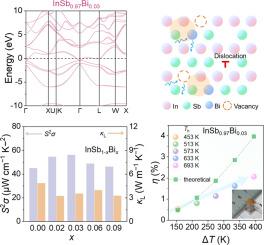Bi-addition improves the thermoelectric performance of InSb
IF 8.3
1区 材料科学
Q1 MATERIALS SCIENCE, MULTIDISCIPLINARY
引用次数: 0
Abstract
Owing to advanced characteristics of a narrow bandgap, high electron mobility, and abundant raw material resources, InSb has been considered as a promising environmental-friendliness thermoelectric material. However, its thermoelectric performance remains unsatisfactory because of its low initial carrier concentration, low electrical conductivity, and high thermal conductivity. Here, we use Bi addition to enhance the thermoelectric performance of InSb. Bi plays two critical roles for the enhanced performance: substituting Sb and forming Bi-rich secondary phase at grain boundaries. First-principles calculations show that BiSb causes the Fermi level to shift into the conduction band, which increases carrier concentration and electrical conductivity. Meanwhile, the enrichment and precipitation of Bi at grain boundaries forms heterogeneous phase boundaries, which induces an energy filtering effect to enhance the Seebeck coefficient and a high power factor of 56.1 μW cm−1 K−2 at 693 K for the InSb0.97Bi0.03, about 42 % higher than that of intrinsic InSb. Additionally, the formation of BiSb point defects and the additional phonon scattering caused by the precipitated phase at grain boundaries result in a reduction in lattice thermal conductivity, collectively resulting in a maximum ZT value of 0.6 at 693 K, approximately 38 % higher than that of intrinsic InSb. Furthermore, the as-fabricated single-leg thermoelectric device based on InSb0.97Bi0.03 achieves an output power of 554 nW under a temperature difference of 395 K, indicating considerable application potential.


添加铋改善了InSb的热电性能
由于具有窄带隙、高电子迁移率和丰富的原料资源等先进特性,InSb被认为是一种很有前途的环境友好型热电材料。然而,由于其初始载流子浓度低、电导率低、导热系数高,其热电性能仍不理想。在这里,我们使用Bi添加剂来提高InSb的热电性能。Bi对合金性能的提高起着两大关键作用:取代Sb和在晶界处形成富Bi的二次相。第一性原理计算表明,BiSb使费米能级转移到导带,从而增加载流子浓度和电导率。同时,铋在晶界处的富集和沉淀形成了非均质相界,引起了能量滤波效应,提高了InSb0.97Bi0.03的塞贝克系数和693 K时的高功率因数56.1 μW cm−1 K−2,比本态InSb高约42%。此外,铋点缺陷的形成和晶界处析出相引起的额外声子散射导致晶格热导率降低,共同导致在693 K时ZT最大值为0.6,比内禀InSb高约38%。此外,基于InSb0.97Bi0.03的单腿热电器件在395 K温差下的输出功率为554 nW,具有较大的应用潜力。
本文章由计算机程序翻译,如有差异,请以英文原文为准。
求助全文
约1分钟内获得全文
求助全文
来源期刊

Acta Materialia
工程技术-材料科学:综合
CiteScore
16.10
自引率
8.50%
发文量
801
审稿时长
53 days
期刊介绍:
Acta Materialia serves as a platform for publishing full-length, original papers and commissioned overviews that contribute to a profound understanding of the correlation between the processing, structure, and properties of inorganic materials. The journal seeks papers with high impact potential or those that significantly propel the field forward. The scope includes the atomic and molecular arrangements, chemical and electronic structures, and microstructure of materials, focusing on their mechanical or functional behavior across all length scales, including nanostructures.
 求助内容:
求助内容: 应助结果提醒方式:
应助结果提醒方式:


